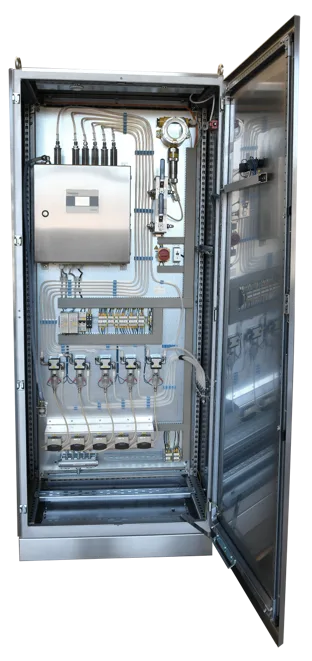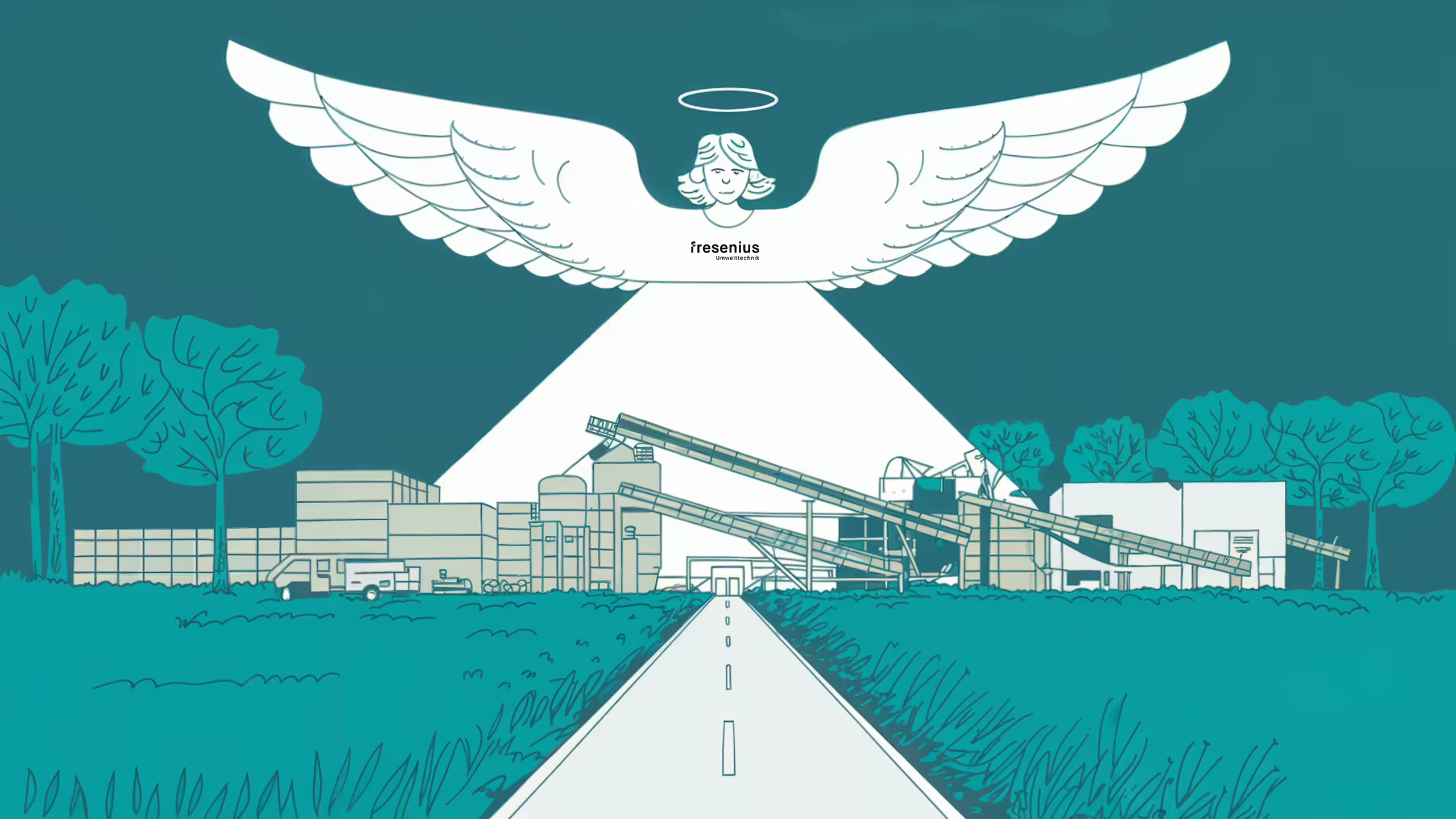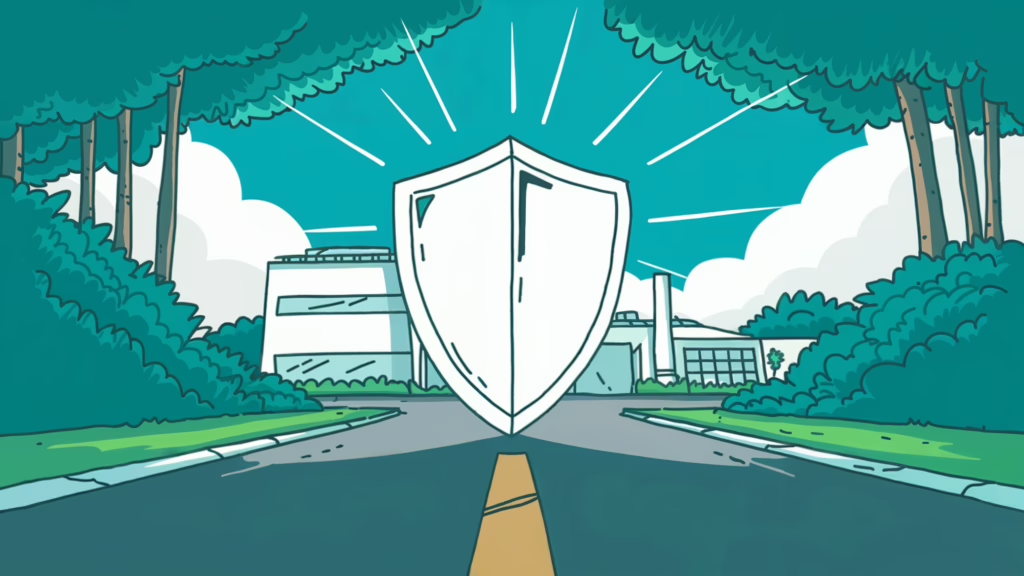Recycling
Safety, efficiency, sustainability and compliance through measurement technology for recycling plants
The recycling industry is a key pillar of the circular economy and faces the challenge of making processes safe, efficient and environmentally friendly. Whether in the pyrolysis of plastics, the processing of electronic waste or the production of biogas, monitoring relevant gases – including combustible, toxic and climate-impacting gases and gases that affect biological processes – is essential for safe, environmentally friendly and efficient plant operation. At the same time, precise gas monitoring enables adherence to strict legal regulations and supports companies in meeting their compliance requirements.
With solutions from Fresenius Umwelttechnik, you can rely on high-precision measurement technologies that have been specially developed for the harsh conditions in recycling plants.
Areas
The areas shown here represent a selection. We can find solutions for a wide range of applications on request.
Solutions
Precise measurement technology for safe and efficient refrigerator recycling processes
In refrigerator recycling, every second counts in terms of safety, efficiency and cost-effectiveness. Our measurement technology ensures optimum results at all critical points in the process - from shredding to exhaust air control.
Safety and speed go hand in hand
When shredding older systems, our systems continuously monitor oxygen (O₂), hydrocarbons (HCs) and CFCs to minimize explosion risks. Real-time measurements in the nitrogen atmosphere allow you to detect hazards such as smouldering fires (via CO monitoring) immediately without slowing down the process unnecessarily. Thanks to this precision, systems can be controlled dynamically: Instead of building in blanket safety buffers, shredding only runs at safe levels - enabling faster recycling cycles.
For efficient system management, our measurement technology also allows you to differentiate between appliances containing pentane and CFCs, so that each model is automatically sent to the most efficient recycling path. The result: a throughput of less than two minutes per refrigerator, with minimal energy consumption and zero manual delays.
Compliance as an automatic process
We also set standards in exhaust air monitoring. Whether under extreme conditions after combustion (high humidity, heat) or with low limit values (< 20 mg/m³ CFCs) - devices such as the GA320 record precise emission data and contribute to complete documentation.
Pyrolysis and gasification processes play a central role in the modern circular economy to convert plastic waste into recyclable synthetic oils, base chemicals or fuel gases. However, these high-temperature processes produce gaseous by-products, the control of which is essential: carbon monoxide (CO) - a toxic gas that is harmful to health even in low concentrations - methane (CH₄), which forms explosive mixtures from 4.4% by volume, and oxygen (O₂), the fluctuations of which affect the combustion quality.
Our solutions start here by continuously recording the concentration of these gases. The monitoring of CO not only serves to protect the health of employees, but also to prevent operational disruptions. At the same time, CH₄ values are analyzed in order to proactively identify risks from explosive mixtures and initiate countermeasures. Precise measurement of the oxygen content enables automatic control of the combustion air supply - this optimizes process efficiency, reduces unburned residues and lowers energy requirements.
You benefit from this comprehensive gas analysis in several ways:
-
Safety: Early warning systems minimize risks for people and equipment.
-
Process stability: Constant O₂ control improves the conversion rate of the starting material and increases product quality.
-
Compliance: Compliance with the EU Industrial Emissions Directive (IED) is supported by seamless documentation of emission values.
-
Economic efficiency: Reduced downtimes, optimized fuel use and higher yield reduce operating costs in the long term.
The data collected also supports sustainability strategies - for example, by providing evidence of CO and CH₄ reductions in ESG reports or in CO₂ balancing.
During metal recycling, the processing of scrap metals, electronic components or batteries produces various critical gases that can affect safety, compliance with legal regulations and process quality.
Nitrogen oxides (NOx) and sulphur dioxide (SO₂) are released in particular when copper-containing materials or contaminated alloys are melted. They can exceed legal emission limits - for example in accordance with the BImSchV or TA Luft. Hydrogen (H₂) is produced during the recycling of lithium-ion batteries or aluminum scrap and forms an explosive mixture from as little as 4 percent by volume. Fluctuating oxygen concentrations (O₂) in smelting furnaces also often lead to incomplete combustion, increased energy consumption and the formation of harmful by-products such as nitrogen dioxide (NO₂).
This is exactly where our gas monitoring solutions come in: They minimize risks and increase process efficiency at the same time. Continuous monitoring of NOx and SO₂ ensures compliance with legal emission limits and enables precise control of exhaust gas purification systems. Critical H₂ concentrations are detected at an early stage in order to initiate automatic safety measures such as extraction or shutdown. O₂ measurements optimize the combustion air supply in real time, reduce fuel consumption and promote more complete metal conversion.
When recycling electronic waste, critical process steps such as shredding, melting or thermal decontamination produce hazardous gases that endanger both people and the environment. When fluorinated or chlorinated plastics are heated - for example in PVC-insulated cables or printed circuit board coatings - highly corrosive gases such as hydrogen fluoride (HF) and hydrogen chloride (HCl) are released. These substances not only cause serious damage to employees' health, but can also attack system components. At the same time, incomplete combustion of adhesives or resins produces carbon monoxide (CO), an odorless, toxic gas that poses an acute risk of poisoning even in low concentrations. There is also the risk of dioxin and furan formation in incinerators if the oxygen (O₂) content is not precisely controlled. These persistent organic pollutants (POPs) accumulate in the environment and are subject to strict international regulations such as the EU POPs Regulation 2019/1021.
This is where our gas analysis solutions come in: With electrochemical sensors (EC), HF and HCl are reliably detected even in the low ppm range. This measurement technology enables the preventive control of extraction systems or chemical scrubbers in order to safely comply with limit values - such as the limit values for HCl in accordance with the German Federal Immission Control Act (BImSchV). At the same time, NDIR sensors monitor the CO concentration in real time. This allows combustion processes to be optimized and health risks to be minimized. The key to dioxin prevention is precise oxygen measurement using zirconium oxide sensors: real-time control of the O₂ supply in post-combustion zones reduces the formation of toxic by-products while simultaneously lowering the energy requirements of the furnaces.
This combines safety, resource efficiency and sustainability to create a future-proof overall concept for modern recycling companies.
Biogas plants play a central role in the sustainable recycling of organic waste - whether in agriculture, the food industry or municipal recycling. The fermentation of biowaste, sewage sludge or green waste produces an energy-rich gas mixture of methane (CH₄) and carbon dioxide (CO₂), which can also contain critical components such as hydrogen sulphide (H₂S) or unwanted oxygen (O₂). Uncontrolled H₂S concentrations lead to corrosion in combined heat and power plants (CHPs), while O₂ in fermenters jeopardizes anaerobic process stability. Methane leaks also pose risks (lower explosion limit: 4.4% CH₄ by volume) and drive up the CO₂ balance without being detected.
This is exactly where our gas analysis solutions come in: NDIR sensors are used to precisely monitor the composition of the biogas - from the CH₄ yield in the fermenter to the purity of the processed biomethane. The infrared technology reliably detects CH₄ and CO₂ even in the presence of high levels of moisture or dust, which is typical of recycled biowaste. At the same time, electrochemical sensors (EC) measure hydrogen sulphide (H₂S) in the low ppm range in order to activate absorption stages at an early stage and reduce the H₂S concentration below the corrosion limit of 100 ppm. O₂ measurement is used for safety in gas storage facilities or pipeline networks: it detects even the slightest oxygen ingress (from 0.1% by volume), which could indicate leaks or leaks and promote explosive mixtures.
Continuous gas monitoring turns biogas plants into reliable pillars of the circular economy:
-
- Maximum energy efficiency: Optimize the yield of usable CH₄ through stable fermentation conditions.
- System protection: Prevent expensive damage to CHP units with proactive H₂S separation.
- Explosion protection: Avoid downtimes with automatic alarms at CH₄ or O₂ limit values.
- Climate relevance: Document reduced methane emissions for the EU taxonomy or voluntary CO₂ compensation programs.
Landfill gas is produced by the decomposition of organic waste and is made up of various main and trace gases, which entail both energy potential and safety-related risks. Our gas analysis systems precisely record the most important components to ensure the safe, efficient and compliant operation of your plant.
Methane (CH₄) is the main component with up to 70 % by volume. As a combustible greenhouse gas, it is continuously monitored in order to avoid explosion hazards and optimize energy use in CHP plants. At the same time, methane measurement supports compliance with climate protection requirements.
Carbon dioxide (CO₂) provides valuable information on the degree of maturity of the landfill and for controlling gas extraction. A stable CO₂ concentration is a prerequisite for efficient recycling and improves the carbon footprint.
Oxygen (O₂) and nitrogen (N₂) indicate air ingress - a risk for smouldering fires and leaking landfill liners. Monitoring them ensures operational stability and protects against uncontrolled reactions.
Hydrogen sulphide (H₂S) is particularly critical: even in low concentrations, it is toxic and corrosive. The measurement protects employees as well as gas pipes and CHP units from damage.
Our solutions enable continuous monitoring of all relevant gases - for greater safety, efficiency and sustainability in your landfill gas utilization.
Matching products:
The ExGard is an explosion-proof gas detector specially developed for monitoring toxic and flammable gases such as methane (CH₄), carbon monoxide (CO) and oxygen (O₂). It works in critical industrial environments and ensures maximum safety.
The Gas Analyzer 220 is your reliable partner for the precise analysis of up to six process gases in almost any industrial environment. This multi-gas analyzer offers state-of-the-art technology to meet the highest standards of accuracy, safety and reliability.
The BioBasic Gas Analyzer is the ideal measuring device for fast and reliable online measurement in biogas plants, sewage treatment plants and landfills. Developed to measure the quality of process gases, it enables efficient process control and thus contributes to the stability and economic efficiency of your plant.
The Gas Analyzer 320 is the ideal solution for the analysis of up to 6 IR-active gases in a wide range of industrial processes. With its ability to detect the lowest detection limits and comprehensive cross-sensitivity compensation, it sets new standards in gas analysis.
Reduce energy costs with biogas

Biogas plants play a key role in the sustainable recycling of organic waste – whether in agriculture, the food industry or municipal recycling. The fermentation of biowaste, sewage sludge or green waste produces an energy-rich gas mixture of methane (CH₄) and carbon dioxide (CO₂), which can also contain critical components such as hydrogen sulphide (H₂S) or unwanted oxygen (O₂). Uncontrolled H₂S concentrations lead to corrosion on all system components, while O₂ in fermenters jeopardizes anaerobic process stability.
This is exactly where our gas analysis solutions come in: NDIR sensors are used to precisely monitor the composition of the biogas – from the CH₄ yield to the purity of the processed biomethane. The infrared technology reliably detects CH₄ and CO₂ even in the presence of high levels of moisture or dust, which is typical of recycled biowaste. At the same time, electrochemical sensors (EC) measure hydrogen sulphide (H₂S) in the low ppm range in order to activate absorption stages at an early stage and reduce the H₂S concentration below the corrosion limit.
Custom Solutions
Every system has its own requirements – and we deliver the right solution. Whether compact system cabinets, customized integration into existing infrastructures or completely individual concepts: We develop solutions that are precisely tailored to your needs.
Our approach makes it possible to optimally combine high-performance gas analyzers and other process measurement technologies – whether in a centrally organized housing or through flexible integration directly into your existing system. You not only save space, but also benefit from a well thought-out structure that makes maintenance and operation easier.
These engineering services are complemented by our comprehensive service concept. If required, the components can be easily removed and sent in for maintenance – alternatively, our experienced service team is available to support you directly on site. This maintenance model guarantees minimal downtime and ensures the continuous operation of your system.

Your advantages
Safety for systems and employees
With our real-time gas warning systems, you can detect potential hazards from flammable and toxic gases before they become a risk. This not only protects your employees, but also ensures the smooth and legally compliant operation of your recycling plant.

High precision
Our measuring devices measure precisely and reliably. This is crucial in order to optimally control processes, maximize energy yield and effectively control emissions.

Protection of your system
Protect infrastructure from corrosion (e.g. with H₂S) and reduce downtime due to maintenance work.

Long-term cost reduction
Our appliances are designed for a long service life and minimal maintenance. This reduces the running costs of your system.

All-round service
With our on-site service and the option to easily send in devices for maintenance, you can always be sure that the monitoring in your system is running smoothly.

FAQ
How economical is it to invest in gas monitoring systems?
The payback period depends on the size of the system and the process conditions. Due to energy savings (e.g. when emissions are exceeded) and higher productivity, the technology can generally pay for itself within a short period of time.
Which gases can be measured in recycling plants?
Our solutions detect many relevant gases, including toxic substances (CO, HCl, NOx), explosive gases (e.g. CH₄, H₂) and process gases (O₂, CO₂). The exact selection depends on your specific application.
Many other substances can be added on request.
Can the systems be integrated into existing installations?
Yes, our solutions have a modular design and can be seamlessly integrated into standard control systems. Retrofitting usually takes place without any significant interruptions to production.
How reliable are the sensors under extreme conditions?
Our technology is designed for use in demanding environments such as high temperatures, humidity or dust. NDIR and zirconium oxide sensors are particularly robust and durable.
Which regulations are covered by your systems?
Our measuring and monitoring systems support compliance with relevant legal requirements, including the EU Industrial Emissions Directive (IED), explosion protection requirements in accordance with ATEX and national regulations such as the Federal Immission Control Ordinance (BImSchV). The continuous recording and documentation of measurement data makes it easier to provide evidence to the authorities and considerably simplifies audits.
How do the systems contribute to sustainability reporting?
Our systems reliably record emissions-relevant data and thus create a sound basis for transparent documentation. This provides companies with targeted support in the preparation of ESG reports.
How often is sensor maintenance required?
Our devices must be serviced once a year. Depending on requirements, however, more frequent maintenance may also be necessary, for example if electrochemical sensors need to be replaced more frequently due to increased stress.

We use cookies and similar technologies to store and/or access device information. With your consent, we and our partners may use this data for ads personalization, measurement, audience insights, product development, security and fraud prevention. Furthermore, Google will use your personal data, among other purposes, to deliver and personalize ads when you give consent on this site (see How Google uses data). Other providers and details on how they use your data can be found in our Cookie Policy. If you don’t consent or withdraw your consent, certain areas, features and functions may be affected. You can change or withdraw your consent anytime via the white button permanently displayed at the bottom left of your browser window.
Functional Always active
Preferences
Statistics
Marketing

Functional Always active
Preferences
Statistics
Marketing
- ←
-
Contact us
Contact us
- WhatsApp us!
- Mail us!
- Call now!
